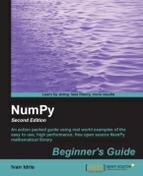Chapter 1, NumPy Quick Start will guide you through the steps needed to install NumPy on your system and create a basic NumPy application.
Chapter 2, Beginning with NumPy Fundamentals introduces you to NumPy arrays and fundamentals.
Chapter 3, Get to Terms with Commonly Used Functions will teach you about the most commonly used NumPy functions—the basic mathematical and statistical functions.
Chapter 4, Convenience Functions for Your Convenience will teach you about functions that make working with NumPy easier. This includes functions that select certain parts of your arrays, for instance, based on a Boolean condition. You will also learn about polynomials, and manipulating the shape of NumPy objects.
Chapter 5, Working with Matrices and ufuncs covers matrices and universal functions. Matrices are well known in mathematics and have their representation in NumPy as well. Universal functions (ufuncs) work on arrays element-by-element or on scalars. Ufuncs expect a set of scalars as input and produce a set of scalars as output.
Chapter 6, Move Further with Numpy Modules discusses the number of basic modules of Universal functions. Universal functions can typically be mapped to mathematical counterparts such as add, subtract, divide, and multiply.
Chapter 7, Peeking into Special Routines describes some of the more specialized NumPy functions. As NumPy users, we sometimes find ourselves having special needs. Fortunately, NumPy provides for most of our needs.
In Chapter 8, Assure Quality with Testing you will learn how to write NumPy unit tests.
Chapter 9, Plotting with Matplotlib covers in-depth Matplotlib, a very useful Python plotting library. NumPy on its own cannot be used to create graphs and plots. But Matplotlib integrates nicely with NumPy and has plotting capabilities comparable to Matlab.
Chapter 10, When NumPy is Not Enough – SciPy and Beyond goes into more detail about SciPy, we know that SciPy and NumPy are historically related. SciPy, as mentioned in the History section, is a high level Python scientific computing framework built on top of NumPy. It can be used in conjunction with NumPy.
Chapter 11, Playing with Pygame is the dessert of this book. We will learn how to create fun games with NumPy and Pygame. We also get a taste of artificial intelligence.
